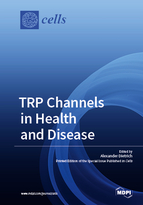TRP Channels in Health and Disease
A special issue of Cells (ISSN 2073-4409).
Deadline for manuscript submissions: closed (31 December 2018) | Viewed by 91393
Special Issue Editor
Special Issue Information
Dear Colleagues,
Transient receptor potential (TRP) channels represent an extended family of 28 members fulfilling multiple roles in the living organism. Over the last few years, new findings on TRP channels reveal an exceptionally broad spectrum as cellular sensors and effectors. Body temperature control, transmitter release from neurons, mineral homeostasis, chemical sensing, and survival mechanisms in a challenging environment are only a few functions which are tightly controlled by these channels. More than 20 hereditary human diseases in areas as diverse as neurology, cardiology, pulmonology, nephrology, dermatology, and urology caused by mutations in 11 TRP genes emphasize their truly remarkable diversity and underscore their essential role in vivo. Moreover, TRP channels are important pharmacological targets for specific novel therapeutic treatment options for patients suffering from diseases caused by dysfunctional TRP proteins. Along these lines, specific TRP inhibitors and activators were identified in the lasts years and are now tested in vitro and in vivo. At the cellular level, TRP channels can be activated by diverse chemical and physical stimuli and are involved in the regulation of the influx of external Ca2+—a universal second messenger regulating diverse cellular functions. However, TRP proteins do not function in isolation, but are organized as structural and functional protein modules in complex signal transduction pathways to execute essential tasks of the cell which are still under investigation. This special issue of Cells will feature a collection of excellent review articles summarizing the current state of the art on TRP channel research with a main focus on TRP channel activation, their physiological and pathophysiological function, and their roles as pharmacological targets for future therapeutic options.
Prof. Dr. Alexander Dietrich
Guest Editor
Manuscript Submission Information
Manuscripts should be submitted online at www.mdpi.com by registering and logging in to this website. Once you are registered, click here to go to the submission form. Manuscripts can be submitted until the deadline. All submissions that pass pre-check are peer-reviewed. Accepted papers will be published continuously in the journal (as soon as accepted) and will be listed together on the special issue website. Research articles, review articles as well as short communications are invited. For planned papers, a title and short abstract (about 100 words) can be sent to the Editorial Office for announcement on this website.
Submitted manuscripts should not have been published previously, nor be under consideration for publication elsewhere (except conference proceedings papers). All manuscripts are thoroughly refereed through a single-blind peer-review process. A guide for authors and other relevant information for submission of manuscripts is available on the Instructions for Authors page. Cells is an international peer-reviewed open access semimonthly journal published by MDPI.
Please visit the Instructions for Authors page before submitting a manuscript. The Article Processing Charge (APC) for publication in this open access journal is 2700 CHF (Swiss Francs). Submitted papers should be well formatted and use good English. Authors may use MDPI's English editing service prior to publication or during author revisions.
Keywords
- TRP channels
- TRP function on an organismal, cellular, and molecular level
- TRPs and pathophysiological function
- TRP modulators as new therapeutic options







